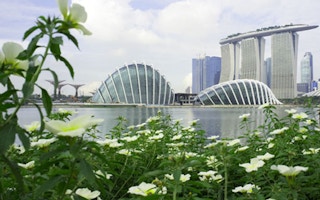National Development Minister Khaw Boon Wan said Singapore welcomes partnerships to test-bed urban solutions here.
Singapore has been active in planning technology parks, building townships and developing entire eco-cities in foreign cities.
Mr Khaw, who was speaking at the 4th Binhai Forum and Expo in Tianjin, said Singapore like any city is a work-in-progress as the Singapore story continues to be written.
Mr Khaw cited the Suzhou Industrial Park, the Sino-Singaporean Tianjin Eco-city and Sino-Singapore Guangzhou Knowledge City as prime examples of partnerships.
Mr Khaw said these help chart a practical development path towards improving people’s welfare.
Mr Khaw also shared what Singapore is doing to build on the strong foundation after 48 years of development.
He said greenery in developments is emphasised in Singapore as part of efforts to make the country a “City in a Garden”.
Mr Khaw gave examples of rooftop gardens, vertical greenery, and park connectors as ways to have more greenery in Singapore.
Another area is in intensifying land use. Besides reclaiming land from the sea, Mr Khaw said Singapore is tapping underground spaces and expanding their use beyond transport and storage.
Singapore is also doing more to conserve its rich biodiversity in the urban environment.
Mr Khaw cited the example of a successful conservation programme for the Oriental Pied hornbill which was once thought to be extinct in Singapore.
Now, there are more than 100 hornbills in Singapore.
Mr Khaw said the government is also working on getting smooth otters to flourish again in some of the rivers and wetlands in Singapore.
As for the built environment, Mr Khaw said all new buildings are now required to achieve the Green Mark. He said the target is to have 80 per cent of all buildings here, including existing ones, achieve Green Mark certification by 2030.
In addition, all land reclamation projects are required to be built at least 2.25 metres above the highest recorded tide level to protect against long-term sea level rise.
As for public transport, Mr Khaw said heavy investments are being made in this area so that commuters can progressively leave their cars behind at home.
He also said improvements are being made to the cycling infrastructure in the city, creating more car-free zones especially in the evenings and on weekends.
Mr Khaw shared how Singapore takes care to preserve the link to its past, heritage and memories.
Citing the example of the development of the Bidadari cemetery, he said the graves had to be exhumed for housing developments but added the heritage of the cemetery and pioneers will be commemorated through a Memorial Garden with selected tombstones and relics.
Lastly, Singapore is committed to long-term and comprehensive planning up to 50 years ahead, for example planning beyond 2030 for the airport and sea port.
He said this is to ensure the continuing relevance of Singapore as a global hub for international trade.

















